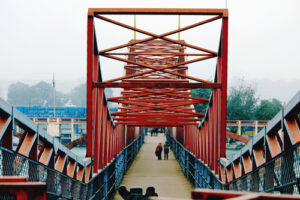 Nowadays the process of main steel reinforcement corrosion is one of the most frequent problems that evokes structural deterioration and reduces its durability. However, the development of a new kind of long-gauge fiber Bragg grating sensor enables us to detect and quantify corrosion damage via a two-level strategy.
Nowadays the process of main steel reinforcement corrosion is one of the most frequent problems that evokes structural deterioration and reduces its durability. However, the development of a new kind of long-gauge fiber Bragg grating sensor enables us to detect and quantify corrosion damage via a two-level strategy.
The main advantage of the novel long-gauge FBG sensor compared with the conventional strain sensors is the possibility to use it for both local and global structural monitoring. The principle of FBG technology operation is based on the measurement of the averaged strain within a long gauge length.
It should be noted that the new FBG system is based on the dynamic macro strain responses of FBG sensors. The technology of the strain flexibility detects the location of the corrosion process, and then it quantifies the corrosion by analyzing the sensitivity of strain flexibility.
Moreover, the technology of fiber Bragg grating sensors provides the following benefit that lies in highly accurate and effective corrosion quantification that is possible to be performed in a reduced domain. Herewith, the FBG sensing system has shown great results while testing in the marine environment.
The FBG technology is highly effective in the detection of structural corrosion, but unfortunately, fails to determine the corrosion process unless the apparatus covers the corroded part. Nevertheless, the FBG-based strain sensor remains the most popular due to the use of small, lightweight optical fibers that allow being easily attached to the surface of any steel reinforcement.
The main difference between the new fiber Bragg grating sensors and traditional ones is that civil structures with a large scale and complex shapes very often contain a high quantity of unknown factors that make the process of analysis slower and more complicated. Also, compared to long-gauge FBG sensors, most damage detection techniques are able to detect damage, but can not quantify the severity.
Thus, the distributed long-gauge fiber Bragg grating sensor is a very promising technology for the efficient and precise location of the corrosion damage and further structural long-term performance estimation. Herein, researchers have developed a step-by-step strategy that would help to detect and quantify the process of corrosion, and even proved it by a solid theoretical basis.
Finally, the novel two-level corrosion detection by the FBG sensing system provides a decisive superiority because the corrosion detection significantly reduces the number of unknown factors in the sensitivity equations and increases the success of the corrosion quantification.
Optromix is a fast-growing vendor of fiber Bragg grating (FBG) products line such as fiber Bragg grating sensors, FBG interrogators and multiplexers, Distributed Acoustic Sensing (DAS) systems, Distributed Temperature Sensing (DTS)systems. The company creates and supplies a broad variety of fiber optic solutions for monitoring worldwide. If you are interested in FBG sensors and want to learn more, please contact us at info@optromix.com

